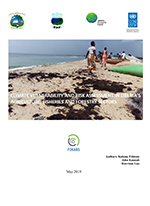
Climate vulnerability and risk assessment Liberia
Year of Publication: 2019
Authors: Kalame Fobissie, John Kannah, Harrison Luog
Abstract
In this report, we assess climate change vulnerability, risks and the impacts on the agriculture, fisheries, and forestry sectors and we propose appropriate adaptation options and action plans for implementation. In conducting this study, we used a combination of methodological approaches and tools including: the IPCC concept of climate vulnerability and risks, the analyses of climate change policy and technical documents, consultations, interviews and group discussions in all the four agroecological zones of Liberia cutting across eight counties, GIS analysis to produce vulnerability maps, stakeholders’ multi-criteria analysis to prioritize adaptation options, transect walk and field observations, triangulation of data, as well as the organization of three technical workshops with resource persons.
The findings reveal that climate change and climate variabilities are already negatively impacting the productivity of the agriculture, forestry, and fisheries sectors and their associated supply chains. Climate change and variabilities also have a social impact and a human dimension as it affects the life of the communities with different effects on women, men and children and the elderly, their lifestyle and reveal their abilities to cope with changes. It is posited that the major climate impacts and hazards will be on the agriculture sector through increased crop loss/failure due to extreme weather events, warmer temperatures, droughts, floods, changing rainfall patterns and distributions, increased pests, weeds, and pathogens which will results to food insecurity and loss of livelihoods in some communities. Warmer temperatures in the country have led to a reduction in chill hours potentially reducing yields for some crops like corn, rice, rubber, coffee, cocoa, and cassava. In addition, livestock population in Liberia is below 10% of national requirements and part of the cause is attributed to impacts of climate change. In the fisheries sector, climate change impacts related to sea level rise, floods, coastal erosions, wind storms and brown tides are affecting fishing, coastal livelihood activities and the coastal ecosystems in Liberia. The forestry sector on the other hand is impacted by increase in temperatures that causes snails to hide and dead of species such as framire.
Increase in temperature also leads to an increase in pests and diseases that affect tree species. Increase in the frequency of intense precipitation leads to erosion and runoff leading to decrease in forest cover and forest health, decrease in flowering of plants and less seed-fruits in walnuts, decrease in yields of Xylopia (aethiopica-country-spot), Piptadeniastrum africanum-Dahoma, rattan and Garcina kola or bitter kola.
Based on the above climate vulnerabilities, impacts and risks in the three sectors, resources persons and stakeholders from the three sectors engaged in a multi-stakeholder process using multicriteria analysis to assess and prioritize appropriate adaptation options. We build on the prioritized adaptation options to prepare and propose an action plan for implementation, composed of four programmes that will benefit the communities at large, as indicated in the table below. The detail action plan provides the estimated cost, proposes organisation and timeline for implementation, men and women beneficiaries, sectors concerned, areas of interest for the Green Climate Fund, activities for male and female and expected result areas among others. Moving forward, we recommend actions for enhancing the implementation of these four programmes and they are related to: sensitization and promotion of collaborative stakeholder implementation process, monitoring and adaptive management of the action plan.
The findings reveal that climate change and climate variabilities are already negatively impacting the productivity of the agriculture, forestry, and fisheries sectors and their associated supply chains. Climate change and variabilities also have a social impact and a human dimension as it affects the life of the communities with different effects on women, men and children and the elderly, their lifestyle and reveal their abilities to cope with changes. It is posited that the major climate impacts and hazards will be on the agriculture sector through increased crop loss/failure due to extreme weather events, warmer temperatures, droughts, floods, changing rainfall patterns and distributions, increased pests, weeds, and pathogens which will results to food insecurity and loss of livelihoods in some communities. Warmer temperatures in the country have led to a reduction in chill hours potentially reducing yields for some crops like corn, rice, rubber, coffee, cocoa, and cassava. In addition, livestock population in Liberia is below 10% of national requirements and part of the cause is attributed to impacts of climate change. In the fisheries sector, climate change impacts related to sea level rise, floods, coastal erosions, wind storms and brown tides are affecting fishing, coastal livelihood activities and the coastal ecosystems in Liberia. The forestry sector on the other hand is impacted by increase in temperatures that causes snails to hide and dead of species such as framire.
Increase in temperature also leads to an increase in pests and diseases that affect tree species. Increase in the frequency of intense precipitation leads to erosion and runoff leading to decrease in forest cover and forest health, decrease in flowering of plants and less seed-fruits in walnuts, decrease in yields of Xylopia (aethiopica-country-spot), Piptadeniastrum africanum-Dahoma, rattan and Garcina kola or bitter kola.
Based on the above climate vulnerabilities, impacts and risks in the three sectors, resources persons and stakeholders from the three sectors engaged in a multi-stakeholder process using multicriteria analysis to assess and prioritize appropriate adaptation options. We build on the prioritized adaptation options to prepare and propose an action plan for implementation, composed of four programmes that will benefit the communities at large, as indicated in the table below. The detail action plan provides the estimated cost, proposes organisation and timeline for implementation, men and women beneficiaries, sectors concerned, areas of interest for the Green Climate Fund, activities for male and female and expected result areas among others. Moving forward, we recommend actions for enhancing the implementation of these four programmes and they are related to: sensitization and promotion of collaborative stakeholder implementation process, monitoring and adaptive management of the action plan.
